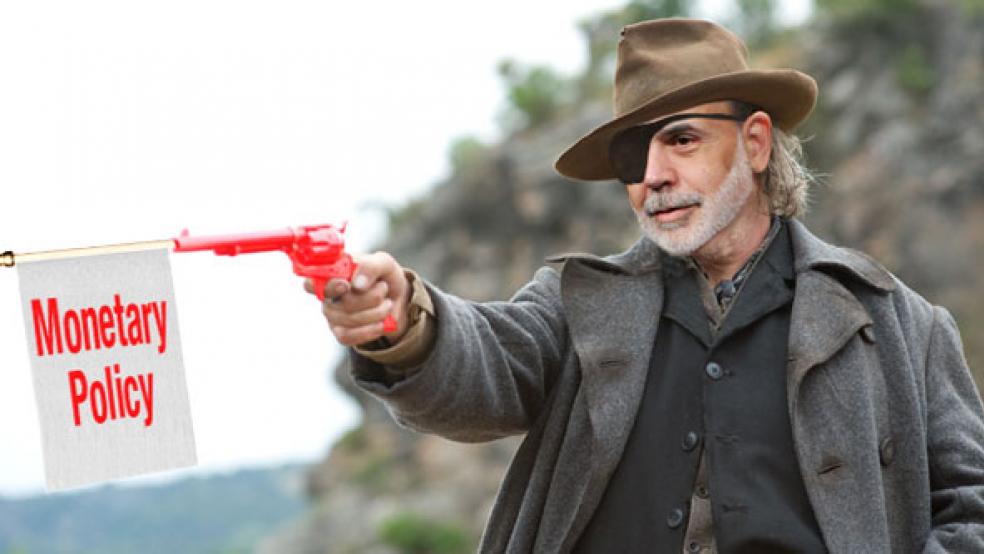The economy has slowed to a walk. Job growth has stalled. And Federal Reserve Board chairman Ben Bernanke showed up on Capitol Hill this week to declare in his semi-annual report to Congress that there wasn’t much he would do about it.
Nearly a year ago, after the pace of new job creation had fallen to less than 60,000 per month, the Fed launched a second round of “quantitative easing” – buying government bonds to pump more money into a faltering economy. This year, after the economy added a measly 18,000 jobs in June, Bernanke said that further easing remained an arrow in his quiver, and that’s exactly where it would stay.
“We’re already highly accommodative,” he told the Senate Banking Committee on Thursday. “The situation today is very different than August 2010.”
That’s bad news for the nation’s 14 million unemployed who face a private sector jobs market showing few hints of revival. Besides the resurgence and expansion of a few industries like auto manufacturing, health care and high end business services, major drivers of economic vigor and the mainstays of middle class well being of recent decades remain deeply depressed. Housing and commercial construction are pale shadows of their pre-recession peaks. State and local governments continue to shed jobs on top of the half million slots they have eliminated since 2008, with the biggest cuts coming at local schools.
Meanwhile, in Washington, the debate over raising the debt ceiling pits a Republican Party committed to not raising taxes against a White House that wants to spread the pain over the next decade. A deficit reduction package comparable to the Bowles-Simpson plan released last December ($4 trillion in deficit reduction over the next decade with three-fourths coming from budget cuts and one-fourth from increased revenues) would shave about a half percentage point of growth off gross domestic product each year, according to some economic projections.
“Both fiscal and monetary policy is being curtailed,” said Joel Prakken, senior managing director of Macroeconomic Advisors, a St. Louis-based advisory firm. “That’s an environment where if you have a shock – and we’re in the midst of one right now – the choices are very limited.”
Bernanke sent a clear message this week that efforts by Tea Party Republicans like Majority Leader Eric Cantor, R-Va., to impose immediate drastic cuts by refusing to raise the debt ceiling would send the economy into a tailspin. “I can only conclude this would be very bad for jobs,” he said. “It really is not an option we should be considering.”
Unfortunately, that response to repeated questions about the debt ceiling debate overshadowed the more subtle message he was trying to send Congress in his testimony about fiscal policy. Setting the nation on a sustainable fiscal path should be the long-term goal, he said, and laying out a plan now on how that will be achieved would be warmly welcomed by financial markets and bolster business confidence.
But in the short-run, there was, if anything, a need for more government action, not less. “On the fiscal side, there are some real tensions,” he responded to a question from Sen. Robert Menendez, D-N.J., who asked if the current level of economic expansion is the best that could be hoped for given the depths of a recession triggered by a financial crisis. “There’s scope for targeted programs, in housing, for instance, but I understand the concerns on both sides of the aisle about the fiscal situation. So it’s a difficult situation,” he said.
That point was underscored in a new report from the Congressional Budget Office, which analyzed the impact of a $2 trillion deficit reduction package at the request of Sen. Kent Conrad, D-N.D., and Sen. Jeff Sessions, R-Ala., the chairman and ranking member of the Senate Budget Committee. Such a package – one possible outcome of the debt ceiling talks – would cut about $100 billion from spending in 2012 rising to $300 billion in 2021.
“In the short term, while the economy is relatively weak and economic growth is restrained primarily by a shortfall in demand for goods and services, the reduction in federal spending or increases in taxes that would produce smaller deficits would decrease the demand for goods and services even further and thus reduce economic output and income,” the CBO report said.
To mitigate the fiscal drag caused by a deficit reduction package, one idea being bandied about by the White House is a renewed effort to unclog the foreclosure logjam, which is hampering a recovery in the housing market, according to Jared Bernstein, a former administration economic advisor who is now a policy analyst at the Center for Budget and Policy Priorities. Fannie Mae and Freddie Mac could temporarily convert foreclosed homes to rental properties instead of dumping them on the housing market, which would help stabilize prices.
Other options Bernstein would like to see considered include an infrastructure program focused on rebuilding schools and renewed aid to beleaguered state governments. “With housing bumping along the bottom, monetary policy at its zero bound, and what growth there is going to the high end, we’re very much in a vicious cycle that points you directly to fiscal stimulus, which we’d be doing if politics wasn’t the restraining factor,” he said.
Of course, plenty of conservative political economists are making counter-arguments, and their acolytes have control of the House. “No growth, no jobs: two rounds of fiscal stimulus have produced neither a sustained rise in growth nor a sustained drop in the unemployment rate,” said John Makin, an economist at the American Enterprise Institute. “Another round would merely increase deficits and debt levels.”





